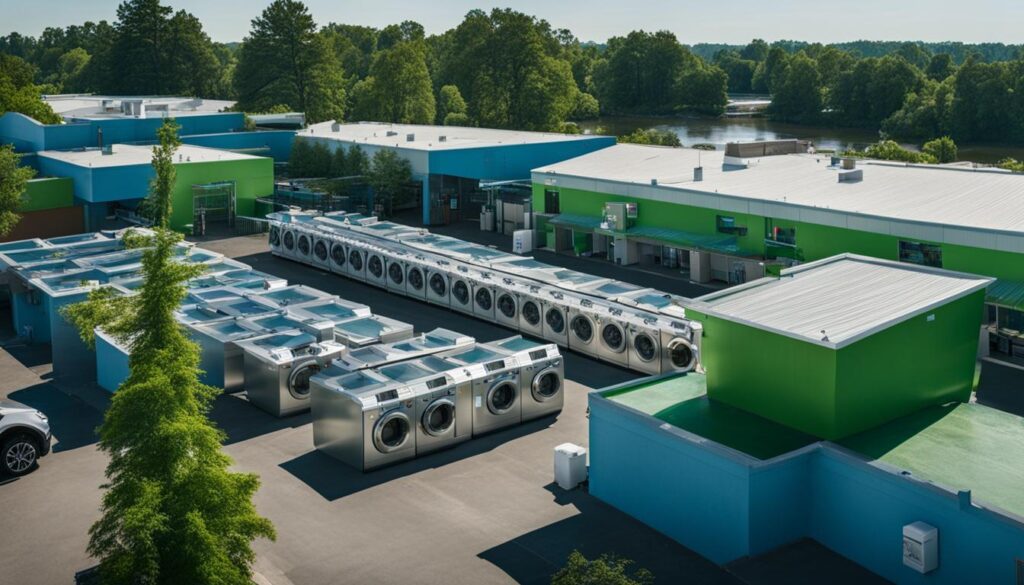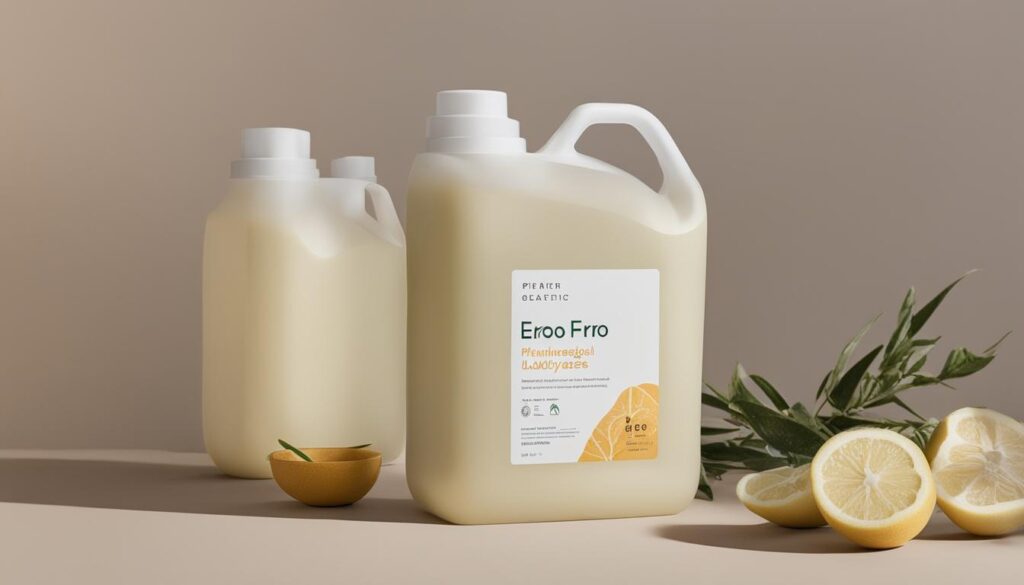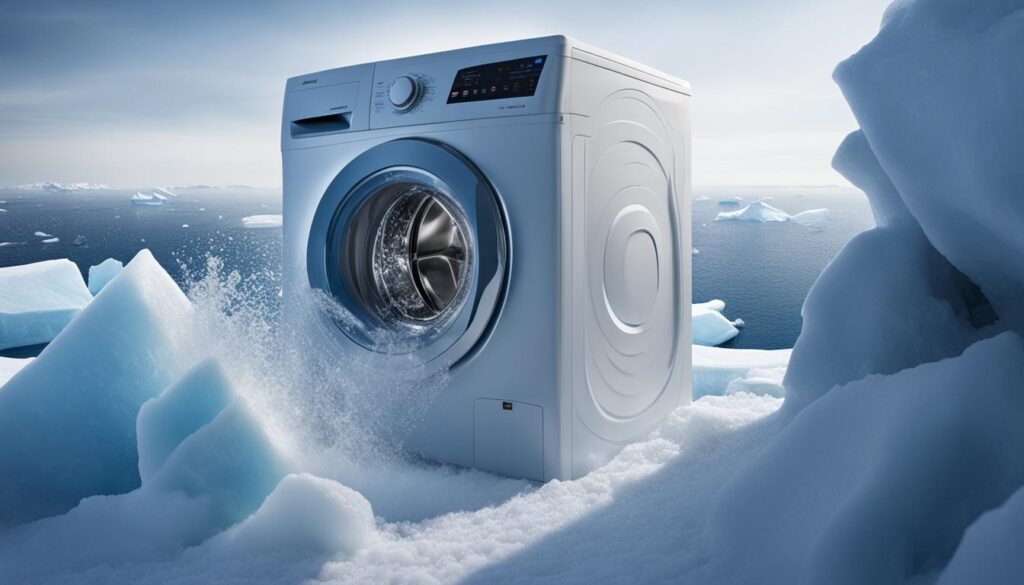Welcome to our Eco-Friendly Laundromat Wash Cycles Guide. Are you ready to transform your laundry routine into a greener and more sustainable one? We’re here to help you adopt eco-friendly wash cycles that reduce your environmental impact and contribute to a healthier planet. By making some simple changes to your laundry practices, you can make a positive difference and play your part in creating a more sustainable future.
Key Takeaways:
- Learn about tips and hacks for greener laundry practices in laundromats.
- Discover the environmental impact of traditional laundry practices and why they need to change.
- Explore laundry detergent alternatives that are kinder to the environment.
- Understand the debate between powder and liquid detergents and make an informed choice.
- Find out the benefits of washing clothes in cold water for energy efficiency and stain removal.
The Environmental Impact of Traditional Laundry Practices
Washing clothes, drying, and ironing together contribute to a significant carbon footprint in a garment’s lifecycle. According to the Fashion Revolution, these activities alone account for approximately a quarter of the carbon emissions associated with clothing production and maintenance.
But it doesn’t stop there. Excessive cleaning can also have adverse effects on clothing, leading to color fading, shrinkage, and misshaping. This results in clothes being discarded and ending up in landfills prematurely, contributing to the growing landfill waste problem.
Moreover, the use of plastic laundry jugs exacerbates environmental concerns. In the United States alone, approximately one billion laundry jugs are discarded each year, with a mere 30% being recycled. This staggering amount of plastic waste has no purpose beyond holding detergent and only adds to the ever-increasing pollution of landfills.
It is essential to recognize the detrimental environmental consequences of traditional laundry practices. By understanding the impact of our actions, we can begin to make informed choices and adopt greener alternatives that help minimize our carbon footprint and reduce the generation of landfill waste.
Excessive cleaning can have adverse effects on clothing, resulting in color fading, shrinkage, and misshaping.
In the next section, we will explore eco-friendly alternatives and practices that can provide a solution to these environmental challenges, creating a more sustainable and conscientious approach to laundry.
Laundry Detergent Alternatives for a Greener Wash
When it comes to doing laundry, there are alternatives to traditional single-use plastic packaging that can help reduce waste and promote a greener wash. By choosing laundry detergent options with eco-friendly packaging and utilizing refill stations, we can make a positive impact on the environment while still effectively cleaning our clothes.
One option to consider is purchasing laundry detergent in plastic-free packaging. Companies like Well Earth Goods offer laundry detergent in pre-measured paper strips, eliminating the need for plastic jugs. These strips are lightweight, easy to use, and dissolve quickly in water, providing a convenient and eco-friendly solution.
Another plastic-free laundry detergent alternative is the use of pods, such as those offered by Dropps. These pods come in a biodegradable, water-soluble film that dissolves completely in the wash, leaving no packaging waste behind. Ethique’s solid Laundry Bar is another great option, packaged in compostable materials that reduce plastic waste.
For those who prefer liquid detergent, visiting zero-waste stores with refill stations is an excellent choice. These stores allow you to bring your own container and fill it with liquid detergents, eliminating the need for single-use plastic bottles. Not only does this reduce packaging waste, but it also encourages the reuse of containers, further reducing our environmental impact.
Exploring Natural Alternatives
If you’re looking to take a more natural approach to laundry, there are alternatives to traditional detergents as well. Vinegar is a natural fabric softener and can help remove odors from clothes. Soap nuts, derived from the soapberry tree, contain a natural cleaning agent and can be used as a gentle detergent. Castile soap, made from vegetable oils, is another effective and chemical-free option.
By embracing these laundry detergent alternatives and seeking out plastic-free packaging and refill stations, we can make a significant difference in reducing plastic waste and promoting a more sustainable laundry routine. Let’s strive for a greener wash that not only keeps our clothes clean but also protects our planet.
The Debate between Powder and Liquid Detergents
When it comes to choosing between powder and liquid detergents for your laundry, there are several factors to consider. Both options have their advantages and disadvantages, and the decision ultimately depends on personal preferences and priorities. Let’s delve into the debate between powder and liquid detergents and explore their pros and cons.
The Pros and Cons of Liquid Detergents
Liquid detergents are popular among many households for their convenience and ease of use. Here are the advantages and disadvantages of opting for liquid detergents:
- Advantages:
- Convenient to measure and pour
- Efficient at dissolving in water, ensuring even distribution
- Often come in recyclable cardboard packaging
- Disadvantages:
- Require more water to rinse out completely
- May contribute to microfiber shedding, causing potential environmental concerns
The Pros and Cons of Powder Detergents
Powder detergents, on the other hand, have been a laundry staple for many years. Let’s explore the pros and cons:
- Advantages:
- Usually more cost-effective, as they come in larger quantities
- Easier to transport and store due to their compact nature
- Disadvantages:
- May cause more friction and potential microfiber shedding
- Can be less convenient to measure and dissolve in water
While both options have their trade-offs, advancements in detergent manufacturing have led to the availability of natural detergents in both powder and liquid forms. These natural detergents are formulated with plant-based ingredients and eco-friendly packaging, providing sustainable alternatives for environmentally conscious consumers.
Choosing between powder and liquid detergents ultimately depends on personal preference and the desire for natural and sustainably produced options.
To help you make an informed decision, here is a visual comparison of the pros and cons:
| Pros | Liquid Detergents | Powder Detergents |
|---|---|---|
| Convenience | ✅ | ❌ |
| Even Distribution | ✅ | ❌ |
| Packaging | ♻️ | 📦 |
| Water Usage | 🌊🌊🌊 | 🌊 |
| Microfiber Shedding | ❌ | ❌ |
| Cost-effectiveness | ❌ | ✅ |
| Transport and Storage | 🚚 | ✅ |
The choice between powder and liquid detergents comes down to personal preference and what aligns with your sustainable laundry goals. Whichever option you choose, be sure to look for natural detergents that are free from harmful chemicals and gentle on the environment. Experimenting with both types of detergents can help you find the perfect eco-friendly solution for your laundry needs.
The Benefits of Washing Clothes in Cold Water
When it comes to laundry, many of us default to using hot water without considering the alternatives. However, washing clothes in cold water can bring numerous benefits to both our wallets and the environment. In fact, according to a study conducted by Harvard University, washing everyday loads in cold water can be just as effective as using hot water.
One of the key advantages of cold water washing is its energy efficiency. Did you know that around 90% of the energy utilized by a washing machine is used to heat the water? By switching to cold water, you can reduce your energy consumption and lower your utility bills. It’s a small change that can make a big difference in the long run.
But energy efficiency isn’t the only advantage. Washing clothes in cold water also helps preserve the color of your garments. Hot water can cause colors to bleed, leading to faded or discolored clothes. By using cold water, you can keep your clothes looking vibrant and fresh for longer.
Another concern when doing laundry is the potential for clothes to shrink. High temperatures can cause fabrics to contract, resulting in ill-fitting clothes that may no longer be usable. Cold water washing helps minimize this risk, as clothes are subjected to milder conditions that are less likely to cause shrinkage.
Additionally, cold water washing can effectively remove many stains, including blood and sweat. Contrary to popular belief, hot water is not always necessary for stain removal. Cold water combined with an appropriate stain remover or detergent can work wonders in lifting even the toughest stains.
By embracing cold water washing, you’re not only saving energy and water but also extending the lifespan of your clothes. It’s a win-win situation for both your wallet and the planet.
So, the next time you do your laundry, consider reaching for that cold water setting. Your clothes and the environment will thank you.
Sustainable Drying Practices
When it comes to drying your clothes, there are eco-friendly alternatives to traditional dryers that consume a significant amount of energy. By adopting sustainable drying practices, you can not only reduce your carbon footprint but also save money on energy bills in the long run.
One of the simplest and most energy-efficient ways to dry your clothes is by air drying. Whenever possible, opt for hanging your clothes outside or using drying racks indoors. This method not only saves energy but also helps preserve the quality of your garments. Plus, there’s nothing quite like the fresh scent of air-dried clothes!
“Air-drying your clothes is a simple yet effective way to reduce energy consumption and promote sustainable living.”
If air-drying is not an option for you due to weather conditions or limited space, consider investing in a heat-pump dryer. Unlike traditional dryers that use heated air, heat-pump dryers use a more energy-efficient process to remove moisture from your clothes. This technology can significantly reduce energy consumption and lower your environmental impact.
Here’s a comparison table showcasing the energy consumption of different drying methods:
| Drying Method | Energy Consumption |
|---|---|
| Air Drying | 0 kWh |
| Heat-Pump Dryer | Low energy consumption |
| Traditional Dryer | High energy consumption |
In addition to choosing an energy-efficient drying method, consider using wool dryer balls instead of single-use dryer sheets. These reusable balls help reduce static electricity, wrinkles, and drying time, making them a more sustainable option for your laundry routine.
By implementing these sustainable drying practices, you can make a positive impact on the environment and embrace a greener lifestyle.
Front-Loading Washing Machines for Water and Energy Efficiency
When it comes to choosing a washing machine, front-loading models are the top choice for water and energy efficiency. Compared to their top-loading counterparts, front-loading machines offer significant benefits in terms of eco-friendliness.
One of the key advantages of front-loading washing machines is their water-saving capabilities. On average, these machines use approximately 7,500 liters less water annually compared to top-loading machines. This reduction in water usage not only helps conserve this precious resource but also contributes to a greener laundry routine.
Another feature that sets front-loading machines apart is their faster spin cycles. These spin cycles are designed to extract more water from the clothes during the washing process, resulting in shorter drying times. By reducing the amount of moisture left in the garments, front-loading machines can help decrease energy consumption by decreasing the drying time required.
While it’s true that front-loading washing machines may have a higher upfront cost compared to top-loading machines, they can lead to long-term savings on water and energy bills. Their energy-efficient design ensures that you consume less power with each wash, ultimately reducing your carbon footprint and contributing to a more sustainable lifestyle.
The Front-Loading Advantage at a Glance:
| Benefits | Front-Loading Machines | Top-Loading Machines |
|---|---|---|
| Water Usage | Approximately 7,500 liters less annually | Higher water consumption |
| Spin Cycles | Faster, more efficient extraction of water from clothes | Slower, less efficient drying process |
| Energy Efficiency | Saves on energy bills in the long run | Higher energy consumption |
With their water-saving capabilities, faster spin cycles, and overall energy efficiency, front-loading washing machines are undoubtedly the environmentally conscious choice. By investing in a front-loading machine, you can enjoy cleaner clothes while reducing your water and energy consumption.
A Greener Approach to Dry Cleaning
Dry cleaning typically involves the use of harsh chemicals that can be harmful to both the environment and human health. As an alternative, consider hand-washing delicate fabrics using mild, eco-friendly soap. Some garments may benefit from using special bags or opting for gentle cycle modes. Liquid silicone and CO2 cleaning are also effective methods for removing stains without the use of traditional dry cleaning solvents.
When it comes to eco-friendly dry cleaning, hand-washing is a sustainable choice that minimizes the use of chemicals and reduces waste. By following proper techniques and using gentle, eco-friendly soap, you can effectively clean your delicate garments while protecting both your health and the environment.
| Traditional Dry Cleaning | Eco-Friendly Hand-Washing |
|---|---|
| Uses harsh chemicals | Uses mild, eco-friendly soap |
| Can be harmful to the environment and human health | Minimizes environmental impact |
| Contributes to chemical waste and pollution | Reduces waste and pollution |
The Benefits of Hand-Washing
- Preserves the integrity of delicate fabrics
- Reduces the risk of color fading and damage
- Minimizes exposure to harsh chemicals
- Lessens carbon emissions associated with dry cleaning facilities
- Requires less energy and resources
By hand-washing your delicate garments, you can ensure their longevity and minimize the environmental impact of dry cleaning processes.
Hand-washing is a versatile and effective method for cleaning various types of clothing, including silk, wool, and cashmere. Taking the time to care for your garments in an eco-friendly way not only benefits the planet but also helps you maintain a sustainable and conscientious lifestyle.
Recycling Laundry Water for Sustainable Living
Recycling laundry water is an innovative and eco-friendly practice that can help reduce water usage and promote sustainable living. By reusing water from your washing machine, you can contribute to conserving this valuable resource and minimize your environmental impact. If you have a garden, collecting and utilizing greywater can also be an excellent way to nourish your plants while saving on irrigation. However, it’s important to follow certain guidelines and consider the use of chemical-free detergents to ensure the health of your plants and the environment.
The Benefits of Greywater Recycling
Greywater is the wastewater generated from household activities like laundry, dishwashing, and bathing. Instead of letting this water go down the drain, greywater recycling allows you to repurpose it for alternative uses, such as irrigation or toilet flushing. This not only reduces the strain on freshwater resources but also lowers the demand for treated water. Additionally, recycling greywater can help promote soil health by providing essential nutrients and improving moisture levels.
When it comes to recycling laundry water specifically, ensuring that it is free from harmful chemicals is crucial. Traditional laundry detergents often contain chemicals that can be detrimental to plant health and damage soil quality. By switching to chemical-free detergents, you can ensure that the greywater used for irrigation is safe and environmentally friendly.
Choosing Chemical-Free Detergents
Chemical-free detergents are an essential component of sustainable laundry practices. These detergents are formulated without harsh chemicals, phosphates, or artificial fragrances, making them safe for the environment and gentle on your clothes. When looking for chemical-free detergents, check for labels such as “biodegradable,” “plant-based,” or “eco-friendly” to ensure you’re making the right choice.
Using chemical-free detergents not only reduces the harmful impact on the environment but also prevents potential damage to your garden. Harsh chemicals found in traditional detergents can disrupt the balance of soil microorganisms and affect plant growth. By opting for greener alternatives, you can maintain a healthy and vibrant garden while practicing sustainable living.
In addition to using chemical-free detergents, installing a greywater filter is essential to capture lint, debris, and other impurities present in the recycled water. This helps prevent clogs in your irrigation system and ensures that only clean water reaches your plants.
A Simple Steps to Recycling Laundry Water
Recycling laundry water for sustainable living involves a few simple steps:
- Install a greywater diversion system: Set up a system that allows you to collect and redirect greywater from your washing machine to a separate storage tank or irrigation system.
- Use a chemical-free detergent: Switch to a biodegradable, plant-based detergent without harsh chemicals or artificial fragrances. This ensures that your greywater is safe for reuse in your garden.
- Consider installing a greywater filter: Install a filter that can capture lint, debris, and other impurities, preventing them from reaching your plants or clogging your irrigation system.
- Determine the appropriate greywater application: Identify the best way to utilize your recycled laundry water, such as watering non-edible plants, trees, or lawns. Make sure to follow local regulations and guidelines for greywater usage.
| Pros | Cons | |
|---|---|---|
| Recycling Laundry Water | – Reduces water usage. | – Requires careful consideration and adherence to guidelines. – Requires the use of chemical-free detergents. – May necessitate the installation of greywater filters for optimal water quality. |
| Using Chemical-free Detergents | – Environmentally friendly. – Gentle on clothes. – Promotes healthy gardens and soil. |
– Available options may have higher costs compared to traditional detergents. |
Recycling laundry water and using chemical-free detergents are powerful ways to lead a more sustainable lifestyle. By implementing these practices, you can make a positive impact on water conservation, reduce your carbon footprint, and contribute to a healthier and greener future.
Microfiber Filters to Reduce Pollution
In our efforts to combat microplastic pollution, we must address one significant contributor – microfibers. These minuscule plastic particles are shed from synthetic clothes during the washing process, ultimately finding their way into our waterways and ecosystems, threatening marine life and contaminating soil.
Traditional wastewater treatment plants are unable to capture these microfibers, underscoring the need for an alternative solution. Enter the Planet Care filter – a game-changer in the fight against microplastic pollution. This innovative filter has been designed to capture around 90% of microfibers, significantly reducing their release into the environment.
Why is the Planet Care filter an indispensable tool in reducing microplastic pollution? Not only is it highly effective in capturing microfibers, but it’s also incredibly easy to install. Whether you choose to attach it directly to your washing machine or install it near a nearby wall, the Planet Care filter seamlessly integrates into your laundry routine, requiring minimal effort for maximum impact.
With its sophisticated filtration system, the Planet Care filter acts as a barrier, capturing the vast majority of microfibers before they have the chance to enter wastewater streams and ecosystems. By implementing this eco-friendly solution, we can significantly reduce the amount of microplastic pollution that plagues our planet.
If you’re committed to mitigating your environmental impact and embracing sustainable living, the Planet Care filter is a crucial investment. By taking decisive action to address microplastic pollution at its source, we can partake in the collective effort to protect our precious waterways, safeguard wildlife, and preserve the health of our planet.
| Benefits of the Planet Care filter: | How it Works: |
|---|---|
| Reduces microplastic pollution | Captures around 90% of microfibers |
| Easy to install and integrate into your laundry routine | Attaches to the washing machine or a nearby wall |
| Effective filtration system | Acts as a barrier to prevent microfibers from entering waterways |
Join the fight against microplastic pollution by installing a Planet Care filter and help pave the way towards a cleaner, more sustainable future.
Eco-Friendly Laundry Products and Detergents
When it comes to making sustainable choices for our laundry routine, selecting the right products and detergents can play a crucial role. Look for the Safer Choice label from the Environmental Protection Agency (EPA) when choosing laundry essentials. The Safer Choice label indicates that the product contains ingredients that are safer for both the environment and human health.
Eco-friendly laundry detergents, fabric softeners, and dryer sheets with the Safer Choice label have undergone rigorous testing to ensure their sustainability and safety. By opting for these products, you can have peace of mind knowing that you’re making a conscious choice that aligns with your eco-friendly goals.
Using products with the Safer Choice label not only benefits the environment but also safeguards your family’s well-being. These products are designed to minimize the use of harmful chemicals and reduce their impact on water sources and ecosystems.
Why Choose Eco-Friendly Laundry Products?
Eco-friendly laundry products offer several advantages over conventional options:
- Reduced environmental impact: Eco-friendly formulas are specifically crafted to minimize water pollution and harm to ecosystems.
- Safe for sensitive skin: Many eco-friendly laundry products are free from harsh chemicals and fragrances, making them suitable for individuals with allergies or sensitivities.
- Sustainability: By supporting brands that prioritize sustainability, you contribute to the overall reduction of greenhouse gas emissions and waste generated by traditional laundry practices.
- Efficiency: Eco-friendly laundry products are formulated to achieve the same or better results as their conventional counterparts, ensuring clean and fresh clothes without compromising performance.
With a wide range of eco-friendly options available, you can find products that cater to your specific needs and preferences. Whether you prefer liquid detergents, powder formulas, or natural scent options, the market offers a variety of choices that align with your commitment to a greener lifestyle.
“Using eco-friendly laundry products with the Safer Choice label not only helps protect the environment but also ensures a healthier home for you and your loved ones.”
Repair and Mend for Sustainable Fashion
Extending the life of your clothes is an essential part of sustainable fashion. Instead of discarding garments with minor snags or tears, mending clothes is a simple yet impactful way to reduce clothing waste and contribute to a more sustainable fashion industry.
Learning basic mending skills allows you to repair small damages and give your clothes a new lease on life. Whether it’s sewing a button back on or patching up small holes, these repairs can be easily done at home with minimal effort and cost.
“Repairing clothes not only saves you money but also helps reduce the demand for new clothing, which in turn decreases the environmental impact of the fashion industry.”
By embracing a repair and mend mindset, you can actively participate in the circular fashion economy and minimize your contribution to the escalating issue of textile waste. Repairing and mending your clothes not only saves valuable resources but also fosters a deeper appreciation for the items in your wardrobe.
Need some mending inspiration? Here are a few techniques you can try:
Sewing
Sewing is a fundamental skill for mending clothes. It allows you to reattach buttons, fix seams, and repair small holes. With a needle, thread, and a basic understanding of sewing techniques, you can tackle many common clothing repairs.
Patching
Patching is an excellent method for concealing larger holes or worn-out areas in your clothes. You can use patches made from scrap fabric, old jeans, or even decorative patches to add a unique touch to your garments while extending their lifespan.
Darning
Darning is particularly useful for repairing holes in knitted or woven fabrics. By using a darning needle and thread, you can weave new threads across the damaged area, reinforcing the fabric and preventing the hole from growing.
Embroidery
Embroidery is a creative way to mend clothes while adding a decorative element. By incorporating colorful threads and intricate stitches, you can transform small tears or frayed edges into beautiful embellishments.
Remember, mending clothes goes beyond repairing damages. It’s about nurturing a sustainable mindset and embracing the value of well-crafted, timeless pieces. By practicing regular mending, you can play an active role in reducing fashion waste and supporting a more sustainable and circular fashion industry.
| Benefits of Mending Clothes | Steps to Mending |
|---|---|
| Reduces clothing waste | Assess the damage |
| Minimizes environmental impact | Gather necessary tools and materials |
| Preserves the lifespan of garments | Choose appropriate repair technique |
| Fosters a more sustainable fashion industry | Follow repair instructions or tutorials |
| Nurtures a sense of creativity and individuality | Practice regularly and improve skills |
Conclusion
Embracing eco-friendly wash cycles and sustainable laundry practices can make a significant impact on reducing carbon emissions, water usage, and waste. By implementing the tips and hacks mentioned in this guide, such as using cold water, air-drying clothes, and choosing environmentally friendly detergents, you can create a greener laundry routine.
By washing clothes in cold water, you can save energy and prevent color fading and shrinking. Air-drying your clothes or using a heat-pump dryer can further reduce energy consumption. Opting for front-loading washing machines and hand-washing delicate fabrics can contribute to water and energy efficiency.
Choosing eco-friendly laundry products and detergents with the Safer Choice label ensures that you are using products that are safer for the environment and your health. Additionally, consider recycling laundry water for watering plants and using microfiber filters to reduce pollution.
Remember, even small changes in daily habits can contribute to a more sustainable lifestyle and a healthier planet. By adopting sustainable laundry practices and embracing eco-friendly solutions, we can all play a part in creating a greener future for ourselves and future generations.
FAQ
How can I make my laundry routine more eco-friendly?
To make your laundry routine more eco-friendly, you can adopt green laundry options such as using biodegradable detergents, reducing water and energy consumption, and choosing sustainable laundry practices like air-drying clothes.
What are some alternatives to traditional laundry detergents?
There are several alternatives to traditional laundry detergents, including detergent strips, laundry pods with eco-friendly packaging, and natural options like vinegar, soap nuts, and castile soap.
Which is better, powder or liquid detergents?
The choice between powder and liquid detergents depends on personal preference. Powder detergents are cost-effective and easier to transport, while liquid detergents often come in recyclable packaging and have less microfiber shedding.
Is washing clothes in cold water effective?
Yes, washing clothes in cold water can be just as effective as washing them in hot water. It reduces energy consumption and prevents color bleeding, shrinking, and certain stains.
What are some sustainable drying practices?
Sustainable drying practices include air-drying clothes by hanging them outside or using drying racks indoors. If air-drying is not an option, consider investing in an energy-efficient heat-pump dryer.
Are front-loading washing machines more eco-friendly?
Yes, front-loading washing machines are more water and energy-efficient compared to top-loading machines. They use less water and have faster spin cycles, which reduce drying time.
How can I dry clean my clothes in an eco-friendly way?
You can opt for hand-washing delicate fabrics using mild, eco-friendly soap instead of traditional dry cleaning. Liquid silicone and CO2 cleaning are also effective methods for removing stains without using harsh chemicals.
Can I recycle laundry water?
Yes, you can recycle laundry water by collecting it before it enters the wastewater system and using it for purposes like watering plants. However, it’s important to use chemical-free detergents and potentially install a greywater filter to capture lint and impurities.
How can I reduce microplastic pollution from laundry?
To reduce microplastic pollution from laundry, you can install a microfiber filter, such as the Planet Care filter, which captures around 90% of microfibers shed from synthetic clothes during washing.
What should I look for in eco-friendly laundry products?
Look for products with the Safer Choice label from the Environmental Protection Agency (EPA). This label indicates that the products contain ingredients that are safer for the environment and human health.
How can I extend the life of my clothes?
You can extend the life of your clothes by learning basic mending skills, such as sewing buttons or patching small holes. Embracing a repair and mend mindset helps reduce clothing waste and supports a more sustainable fashion industry.







